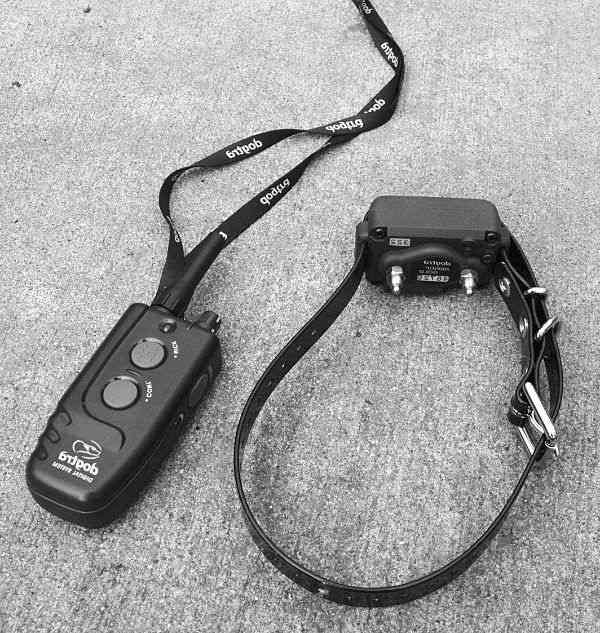Are E-Collars Cruel?
As a pet owner, you may be wondering if an electronic collar (e-collar) is the right tool for training your dog. This type of collar emits a mild electrical current that interrupts your dog’s behavior. Some people believe that e-collars are cruel and inhumane, but others find them to be an effective training tool. So, what’s the truth?
Are e-collars cruel? Let’s take a closer look.
See more: Prong Collar vs Choke Collar: All Things To Know
How Do E-Collars Work?
Before find the anwser for are e-collars cruel, let’s learn about how an e collar work. E-collars deliver a mild electrical current to your dog’s neck. The current is similar to the static shock that you might feel when you touch a metal doorknob after walking across carpet. Depending on the brand and model, e-collars may have different settings to deliver different levels of stimulation. The lowest setting is usually barely noticeable to most dogs, while the highest setting can be uncomfortable.
E-collars are designed to get your dog’s attention, interrupting their current behavior. For example, if your dog is barking, the sudden sensation of the e-collar will startle them and cause them to stop barking. If your dog is chasing a squirrel, the e-collar will interrupt their behavior and cause them to stop and look at you.
The goal is not to hurt or punish your dog, but rather to startle them and get their attention so that you can train them out of unwanted behaviors.
Are E-Collars Cruel?
Now that you know how e-collars work, the next question is are e collars cruel? The answer to this question depends on your definition of “cruel.” If you believe that any type of physical correction is cruel, then yes, e-collars would be considered cruel. However, if you believe that physical correction can be used in a humane way to train dogs, then e-collars are not cruel.
It’s important to note that e-collars should only be used as a training tool and not as a punishment. If used correctly, e-collars can be an effective way to train your dog out of unwanted behaviors. However, if used incorrectly, e-collars can be cruel and inhumane.

Are E-Collars Effective?
E-collars are most effective when used in conjunction with positive reinforcement training. Positive reinforcement is a type of training that rewards your dog for good behavior. For example, if your dog is sitting quietly, you might give them a treat or verbal praise. This type of training is effective because it rewards your dog for the behavior you want to see.
E-collars can be used to deliver positive reinforcement by delivering a mild shock when your dog performs the desired behavior. For example, if you’re training your dog to come when called, you would give them a shock with the e-collar when they come to you. This would teach them that coming to you is a good thing because it results in a positive reinforcement (the shock is stopped).
E-collars can also be used to deliver negative reinforcement, which is when an unpleasant sensation is used to punish your dog for unwanted behavior. For example, if your dog is barking, you might give them a shock with the e-collar to punish them for barking. This would teach them that barking is not tolerated and they should stop if they don’t want to be punished.
While both positive and negative reinforcement can be effective, positive reinforcement is generally considered to be more humane and is less likely to cause fear or anxiety in your dog.
What Is The E-Collar Used For?
Know you already know Are E-Collars Cruel, what is they used for The e-collar is most commonly used to train dogs out of unwanted behaviors, such as barking, chasing, digging, and jumping. It can also be used to train dogs for obedience, such as come when called, sit, stay, and down.
E-collars are not recommended for use with aggressive dogs or dogs with a history of aggression. This is because the e-collar can be used to Punish your dog for unwanted behavior, which could make their aggression worse.
If you’re considering using an e-collar to train your dog, it’s important to consult with a professional trainer or behaviorist first. They can assess your dog’s behavior and temperament to see if an e-collar is right for them. They can also teach you how to use the e-collar correctly so that you don’t accidentally punish your dog for unwanted behavior.

People Who Often Use E-Collars
- Professional dog trainers: Trainers who use e-collars often have years of experience and training in how to use them correctly.
- People who own hunting dogs: Hunting dogs are often trained with e-collars so that they can be controlled off leash.
- People who live on farms: Farmers often use e-collars to train their dogs to stay on their property and to herd livestock.
- People who have escape artists: Dogs who are experts at escaping fences or yards may be trained with an e-collar so that they can be kept safe and secure.
- People with poorly behaved dogs: Dogs who are excessively barkers, jumpers, or diggers may be trained with an e-collar to help them stop these unwanted behaviors.
- People whose jobs involve working with dogs, such as police officers, service dog trainers, etc.
E-collars can be a helpful training tool for people who often work with dogs. They can help train out unwanted behaviors and train dogs for obedience. However, it’s important to consult with a professional trainer or behaviorist first to make sure that an e-collar is right for your dog.
Evaluating The Effectiveness Of Dog Training With E-collars Compared To Traditional Training
Whatever Are E-Collars Cruel, they are an effective tool for dogs trainning. Methods There is much debate over which method of dog training is more effective, with proponents of both traditional methods and e-collars offering strong arguments. However, a study published in the journal “Applied Animal Behaviour Science” in 2016 seems to offer some insight into which method may be more successful. The study compared the effectiveness of training with e-collars versus traditional methods in a group of 18 dogs. The dogs were trained over the course of 12 weeks, and the researchers found that those trained with e-collars made significantly fewer mistakes than those trained with traditional methods.
There are a few possible explanations for why e-collar training may be more effective than traditional methods. One possibility is that the use of positive reinforcement (rewarding the dog for good behavior) in e-collar training is more successful than negative reinforcement (punishing the dog for bad behavior) in traditional training. It’s also possible that the e-collars provide a more consistent form of stimulation than traditional methods, which may help the dogs to learn more quickly.
It is difficult to compare the effectiveness of e-collar training with traditional training methods, as there are many variables that can affect a dog’s behavior. Additionally, each dog is unique and will respond differently to different training methods. Some dogs may learn behaviors more quickly with an e-collar, while others may not respond as well to this type of training.
However, more research is needed to confirm these findings. Overall, the study suggests that e-collar training may be more effective than traditional methods, though more research is needed to confirm these findings. If you’re considering training your dog with an e-collar, be sure to consult with a qualified trainer to ensure that you’re using the device correctly and not causing any undue stress or anxiety in your dog.

Realistic Studies On The Impact Of Electronic Collars On Canine Mental Health
Realistic studies on the impact of electronic collars on canine mental health and welfare are sparse. We investigated whether the use of electronic collars affects the behavior and cortisol concentrations of dogs during training in comparison to a force-free method. The study was conducted with 48 privately owned dogs. One group of dogs (n = 24) was trained using electric shocks from an e-collar as a primary reinforcer, while another group of dogs (n = 24) was trained using positive reinforcement (food rewards and verbal praise).
The dogs in both groups were trained for 30 min/day, and 5 days/week for 8 weeks. Dogs in the e-collar group showed more fearfulness during training than those in the force-free group, as indicated by their lower threshold scores on the C-BARQ Fearfulness subscale. In addition, dogs in the e-collar group had higher post-training cortisol concentrations than those in the force-free group. The results of this study suggest that the use of electronic collars during training may have negative effects on canine mental health and welfare.
These results are concerning, as they suggest that the use of electronic collars may have negative impacts on a dog’s mental health. This is an important issue that warrants further exploration.
It is important to note that this study is based on a relatively small sample size, and thus, these findings should be interpreted with caution. Additionally, it is not clear from the study whether the negative impacts on mental health were due to the electronic collar itself, or to the training method that was used in conjunction with the collar. Future research should aim to investigate these factors in greater detail.
Despite these limitations, this study provides important insights into the potential impacts of electronic collars on dogs. This information is valuable for pet owners, trainers, and policy makers who are considering the use of electronic collars. It is important to consider the potential impacts of electronic collars on dogs before making the decision to use them.
When To Stop Using E-Collars
When Are E-Collars Cruel? E-collars should only be used as a training tool and not as a way to permanently control your dog. Once your dog has learned the desired behavior, you should no longer need to use the e-collar.
If you find that you’re using the e-collar more and more frequently, or that your dog is becoming scared or anxious when they see the e-collar, it’s time to stop using it. These are signs that the e-collar is not working and is causing more harm than good.
E-collars should also be removed if your dog is going to be in a situation where they may be startled or frightened, such as during a thunderstorm. Dogs who are anxious or fearful may react negatively to the shock from the e-collar, which could make their anxiety worse.

Even So, They Are Still Very Effective With Dog Training If Used Correctly
Some user experiences about E-Collars:
- “We have an 8-year-old dog who we adopted from the shelter. He always had a number of annoying issues that were tolerable in the past but after moving into our new house, these problems quickly got worse and started to affect both him and us negatively because they were so severe within such little time frame (a few months). To make matters even more frustrating for me as his human parent; there doesn’t seem like anything at all you can do about it! However, through YouTube searches on how to train dogs properly using positive only counter conditioning methods with some changes made around barking whenever someone knocks or rings their doorbell…I managed to get almost all!”
- “My dog used to be a total headache. She had no recall ability and would tug on her leash until she got attention from me or other dogs we passed by; but now it’s different! With this new e-collar that has 100 levels of stimulus (which means flickering lights), my partner can walk around our subdivision without having any worries about getting clicked away because there are plenty enough choices for what you want your pet’s moods translated into – whether happy calm sleepy etc… And if all else fails then simply press one button when needed :)”
- “Luna is a Keeshond, and she loves walks. We take Luna for two long leisurely paced strolls each day – but even with her favorite collar on hand-in order to avoid any potential owners of chaotic behavior such as biting or jumping around us while we’re out walking together; it seemed like nothing could stop this dog from constantly being active! It didn’t help either that every time someone came near our house (or window), all bets were off: there would be barking laughter everywhere you looked…”
Summary, e-collars can have potential negative impacts on dogs’ mental health, and thus should be used with caution. If you are considering using an e-collar, consult with a professional trainer or behaviorist first to make sure that it is the right training tool for your dog. Once your dog has learned the desired behavior, remove the e-collar and do not use it any more frequently than necessary. If you find that your dog is becoming scared or anxious around the e-collar, stop using it immediately.
FAQs about Are E-Collars Cruel
Why are e collars controversial?
E-collars are controversial because they can have potential negative impacts on dogs’ mental health. When used incorrectly, e-collars can cause fear, anxiety, and stress in dogs. Some people believe that e-collars should only be used as a last resort after other training methods have failed, while others believe that e-collars can be a helpful tool when used correctly.
What are some alternatives to using an e-collar?
Some alternatives to using an e-collar include positive reinforcement training, clicker training, and shaping. These methods focus on rewarding desired behaviors instead of punishing undesired behaviors. Consult with a professional trainer or behaviorist to find out which method is best for your dog.
How do I know if an e-collar is right for my dog?
E-collars should only be used as a last resort after other training methods have failed. If you are considering using an e-collar, consult with a professional trainer or behaviorist first to make sure that it is the right training tool for your dog. Once your dog has learned the desired behavior, remove the e-collar and do not use it any more frequently than necessary. If you find that your dog is becoming scared or anxious around the e-collar, stop using it immediately.
Do shock collars traumatize dogs?
Shock collars can traumatize dogs if they are used incorrectly. E-collars should only be used as a last resort after other training methods have failed. If you are considering using an e-collar, consult with a professional trainer or behaviorist first to make sure that it is the right training tool for your dog. Once your dog has learned the desired behavior, remove the e-collar and do not use it any more frequently than necessary. If you find that your dog is becoming scared or anxious around the e-collar, stop using it immediately.
Are e collars better than prong collars?
There is no definitive answer to this question. E-collars and prong collars are both controversial training tools that can have potential negative impacts on dogs’ mental health. If you are considering using either type of collar, consult with a professional trainer or behaviorist first to make sure that it is the right training tool for your dog. Once your dog has learned the desired behavior, remove the collar and do not use it any more frequently than necessary. If you find that your dog is becoming scared or anxious around the collar, stop using it immediately.
How much are e collars for dogs?
E-collars for dogs can range in price from $30 to $200. The price will vary depending on the features of the collar and the brand. Consult with a professional trainer or behaviorist to find out which type of e-collar is best for your dog. Once your dog has learned the desired behavior, remove the e-collar and do not use it any more frequently than necessary.
What can I use instead of an e-collar?
If an e-collar isn’t an option, there are several alternatives that can help train your pup. One option is clicker training, which relies on positive reinforcement to teach commands and behaviors. Clicker trainers typically use a small handheld device that emits a clicking noise when the desired behavior or command is performed correctly by the dog. This sound acts as a reward, and over time the dog learns to understand that doing the desired behavior results in a reward.
Another option is using head halters or harnesses instead of an e-collar. Harnesses allow you to have more control over your pup’s movements without causing pain or discomfort. Head halters, on the other hand, help control the pup’s head, allowing you to give commands more effectively.
Conclusion
While there is some debate surrounding the use of e-collars, the majority of customers feel that they are an effective and humane way to train their dogs. If you’re on the fence about whether or not to try an e-collar for your pup, we recommend reading customer reviews before making a decision. Have you tried using an e-collar to train your pup? Let us know how it went in the comments below!
Above is the article “Are e collars cruel?”, Thanks for reading!
References:








